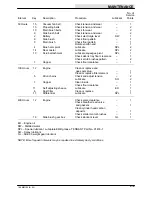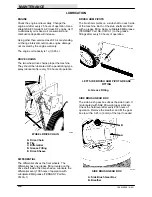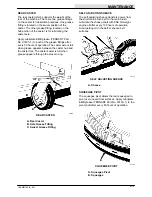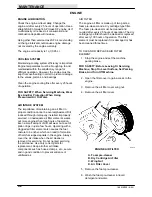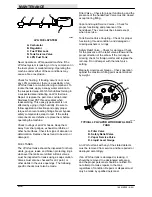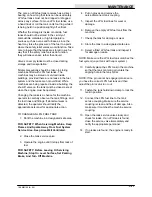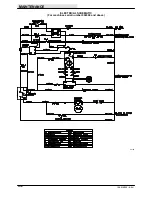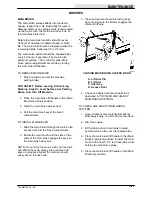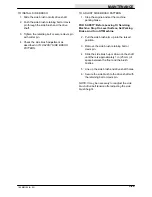
MAINTENANCE
3Ć15
186 MM159 (6–94)
ELECTRICAL SYSTEM
BATTERY
The battery provides the engine with starting
power. It requires regular maintenance to operate
at its best.
The battery is a 12 V, 40 A/h at a 20-hour rate. It
is located in the engine compartment. When
removing battery cables, remove the negative (–)
cable before the positive (+) cable.
Do not allow the battery to remain in discharged
condition for any length of time. Do not operate
the machine if the battery is in poor condition or
discharged beyond 75%, specific gravity below
1.170.
Clean the top surface and the terminals of the
battery periodically. Use a strong solution of
baking soda and water. Brush the solution
sparingly over the battery top, terminals, and
cable clamps. Do not allow any baking soda
solution to enter the battery. Use a wire brush to
clean the terminal posts and the cable
connectors. After cleaning, apply a coating of
clear petroleum jelly to the terminals and the
cable connectors. Keep the top of the battery
clean and dry.
Keep all metallic objects off the top of the battery,
as they may cause a short circuit. Replace worn
or damaged wires.
The electrolyte level must be checked after every
50 hours of operation. It must always be above
the battery plates. Add distilled water to maintain
solution at the correct level above the plates, but
do not overfill. Never add acid to batteries, only
water. Keep vent plugs firmly in place at all times,
except when adding water or taking hydrometer
readings.
FOR SAFETY: When Servicing Machine, Avoid
Contact With Battery Acid.
If when checking battery specific gravity, one or
more battery cells tests lower than the other
battery cells, (0.050 or more) the cell is damaged,
shorted, or is about to fail.
NOTE: Do not take readings immediately after
adding water––if the water and acid are not
thoroughly mixed, the readings may not be
accurate. Check the hydrometer readings against
this chart:
SPECIFIC GRAVITY
BATTERY
AT 80
F (27
C)
CONDITION
1.265
100% charged
. . . . . . . . . . . . . . . . . . . . . . . . .
1.225
75% charged
. . . . . . . . . . . . . . . . . . . . . . . . . .
1.190
50% charged
. . . . . . . . . . . . . . . . . . . . . . . . . .
1.155
25% charged
. . . . . . . . . . . . . . . . . . . . . . . . . .
1.120
Discharged
. . . . . . . . . . . . . . . . . . . . . . . . . . . .
NOTE: If the readings are taken when the battery
electrolyte is any temperature other than 80
F
(27
C), the reading must be temperature
corrected.
To determine the corrected specific gravity
reading when the temperature of the battery
electrolyte is other than 80
F (27
C):
Add to the specific gravity reading 0.004
(4 points) for each 10
F (6
C) above
80
F (27
C).
Subtract from the specific gravity reading
0.004 (4 points) for each 10
F (6
C)
below 80
F (27
C).
Summary of Contents for 186
Page 1: ...186 MM159 Rev 05 12 95 Operator Manual ...
Page 10: ...SPECIFICATIONS 186 MM159 6 94 1Ć2 ...
Page 14: ...OPERATION 186 MM159 6 94 2Ć2 ...
Page 84: ...MAINTENANCE 186 MM159 6 94 3Ć48 ...
Page 86: ...APPENDIX 186 MM159 6 94 4Ć2 ...
Page 88: ...APPENDIX 186 MM159 6 94 4Ć4 ...





